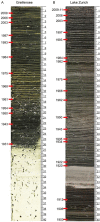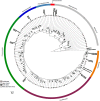Sedimentary DNA Reveals Cyanobacterial Community Diversity over 200 Years in Two Perialpine Lakes
- PMID: 27565621
- PMCID: PMC5066364
- DOI: 10.1128/AEM.02174-16
Sedimentary DNA Reveals Cyanobacterial Community Diversity over 200 Years in Two Perialpine Lakes
Abstract
We reconstructed cyanobacterial community structure and phylogeny using DNA that was isolated from layers of stratified sediments spanning 200 years of lake history in the perialpine lakes Greifensee and Lake Zurich (Switzerland). Community analysis based on amplification and sequencing of a 400-nucleotide (nt)-long 16S rRNA fragment specific to Cyanobacteria revealed operational taxonomic units (OTUs) capturing the whole phylum, including representatives of a newly characterized clade termed Melainabacteria, which shares common ancestry with Cyanobacteria and has not been previously described in lakes. The reconstruction of cyanobacterial richness and phylogenetic structure was validated using a data set consisting of 40 years of pelagic microscopic counts from each lake. We identified the OTUs assigned to common taxa known to be present in Greifensee and Lake Zurich and found a strong and significant relationship (adjusted R2 = 0.89; P < 0.001) between pelagic species richness in water and OTU richness in the sediments. The water-sediment richness relationship varied between cyanobacterial orders, indicating that the richness of Chroococcales and Synechococcales may be underestimated by microscopy. PCR detection of the microcystin synthetase gene mcyA confirmed the presence of potentially toxic cyanobacterial taxa over recent years in Greifensee and throughout the last century in Lake Zurich. The approach presented in this study demonstrates that it is possible to reconstruct past pelagic cyanobacterial communities in lakes where the integrity of the sedimentary archive is well preserved and to explore changes in phylogenetic and functional diversity over decade-to-century timescales.
Importance: Cyanobacterial blooms can produce toxins that affect water quality, especially under eutrophic conditions, which are a consequence of human-induced climate warming and increased nutrient availability. Lakes worldwide have suffered from regular cyanobacterial blooms over the last century. The lack of long-term data limits our understanding of how these blooms form. We successfully reconstructed the past diversity of whole cyanobacterial communities over two hundred years by sequencing genes preserved in the sediments of two perialpine lakes in Switzerland. We identified changes in diversity over time and validated our results using existing data collected in the same two lakes over the past 40 years. This work shows the potential of our approach for addressing important ecological questions about the effects of a changing environment on lake ecology.
Copyright © 2016, American Society for Microbiology. All Rights Reserved.
Figures







Similar articles
-
Diversity and Cyclical Seasonal Transitions in the Bacterial Community in a Large and Deep Perialpine Lake.Microb Ecol. 2018 Jul;76(1):125-143. doi: 10.1007/s00248-017-1120-x. Epub 2017 Dec 1. Microb Ecol. 2018. PMID: 29192335
-
Application of ancient DNA to the reconstruction of past microbial assemblages and for the detection of toxic cyanobacteria in subtropical freshwater ecosystems.Mol Ecol. 2014 Dec;23(23):5791-802. doi: 10.1111/mec.12979. Epub 2014 Nov 21. Mol Ecol. 2014. PMID: 25346253
-
Cyanobacterial diversity in the hot spring, pelagic and benthic habitats of a tropical soda lake.FEMS Microbiol Ecol. 2013 Aug;85(2):389-401. doi: 10.1111/1574-6941.12128. Epub 2013 Apr 25. FEMS Microbiol Ecol. 2013. PMID: 23586739
-
How rising CO2 and global warming may stimulate harmful cyanobacterial blooms.Harmful Algae. 2016 Apr;54:145-159. doi: 10.1016/j.hal.2015.12.006. Harmful Algae. 2016. PMID: 28073473 Review.
-
Health impacts from cyanobacteria harmful algae blooms: Implications for the North American Great Lakes.Harmful Algae. 2016 Apr;54:194-212. doi: 10.1016/j.hal.2016.02.002. Harmful Algae. 2016. PMID: 28073476 Review.
Cited by
-
Investigating variability in microbial community composition in replicate environmental DNA samples down lake sediment cores.PLoS One. 2021 May 3;16(5):e0250783. doi: 10.1371/journal.pone.0250783. eCollection 2021. PLoS One. 2021. PMID: 33939728 Free PMC article.
-
Reconstruction of 100-year dynamics in Daphnia spawning activity revealed by sedimentary DNA.Sci Rep. 2022 Feb 2;12(1):1741. doi: 10.1038/s41598-021-03899-0. Sci Rep. 2022. PMID: 35110566 Free PMC article.
-
Diversity and Cyclical Seasonal Transitions in the Bacterial Community in a Large and Deep Perialpine Lake.Microb Ecol. 2018 Jul;76(1):125-143. doi: 10.1007/s00248-017-1120-x. Epub 2017 Dec 1. Microb Ecol. 2018. PMID: 29192335
-
Host-Associated Bacterial Communities Vary Between Daphnia galeata Genotypes but Not by Host Genetic Distance.Microb Ecol. 2023 May;85(4):1578-1589. doi: 10.1007/s00248-022-02011-x. Epub 2022 Apr 29. Microb Ecol. 2023. PMID: 35486140 Free PMC article.
-
Snapshot Surveys for Lake Monitoring, More Than a Shot in the Dark.Front Ecol Evol. 2018;6:10.3389/fevo.2018.00201. doi: 10.3389/fevo.2018.00201. Front Ecol Evol. 2018. PMID: 32185176 Free PMC article. No abstract available.
References
-
- Rigosi A, Carey CC, Ibelings BW, Brookes JD. 2014. The interaction between climate warming and eutrophication to promote cyanobacteria is dependent on trophic state and varies among taxa. Limnol Ocean 59:99–114. doi: 10.4319/lo.2014.59.1.0099. - DOI
-
- Sukenik A, Quesada A, Salmaso N. 2015. Global expansion of toxic and non-toxic cyanobacteria: effect on ecosystem functioning. Biodivers Conserv 24:889–908. doi: 10.1007/s10531-015-0905-9. - DOI
-
- Chorus I, Bartram J. 1999. Toxic cyanobacteria in water: a guide to their public health consequences, monitoring and management. E & FN Spon, London, England.
Publication types
MeSH terms
Substances
LinkOut - more resources
Full Text Sources
Other Literature Sources
Research Materials
Miscellaneous

